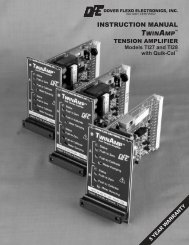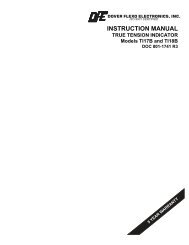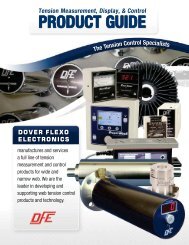TR Instruction Manual - Dover Flexo Electronics, Inc
TR Instruction Manual - Dover Flexo Electronics, Inc
TR Instruction Manual - Dover Flexo Electronics, Inc
Create successful ePaper yourself
Turn your PDF publications into a flip-book with our unique Google optimized e-Paper software.
Appendix B:Selection of Load RatingSELECTION OF LOAD RATING1. LOAD RATINGS. The Model "<strong>TR</strong>"Transducer is available in several standard load ratings, rangingfrom 12 lbs. to 400 lbs. The correct rating for any particular application depends on web tension,transducer roll weight, wrap angle and the direction of the tension force on the transducer roll. Figure 5contains mathematical formulas which use these factors to determine the correct load rating.2. SELECTION PROCEDURE The correct load rating is found in four simple steps:Step 1.OBTAIN DATA TO PLUG INTO THE SELECTION FORMULAa. Compute the weight of the transducer roll and bearing assemblies. Refer to Section 2.2.1.1 for rolland bearing weights.b. Estimate the maximum web tension. Use Appendix C, Typical Tensions, as a guide if necessary.c. Determine the wrap angle.d. Determine the angle of the tension force, F T , relative to the vertical. (NOTE: F T bisects the wrapangle)Step 2. COMPUTE NET FORCE USING THE SELECTION FORMULARefer to Figure 14. Select the appropriate wrap configuration as determined by the direction of thetension force (above, below or on horizontal). Compute the Net Force, using the formula below thewrap diagram.Figure 14 - LOAD RATING SELECTION FORMULASStep 3. SELECT THE LOAD RATINGUse the Load Rating Chart below to select the correct load rating. In some cases, the load rating maybe LESS than the computed Net Force. This is acceptable because the Net Force formula contains anoversizing factor of 2. Therefore the actual force exerted on the transducer will not exceed its rating, ifthe transducer is chosen according to the chart.21
















